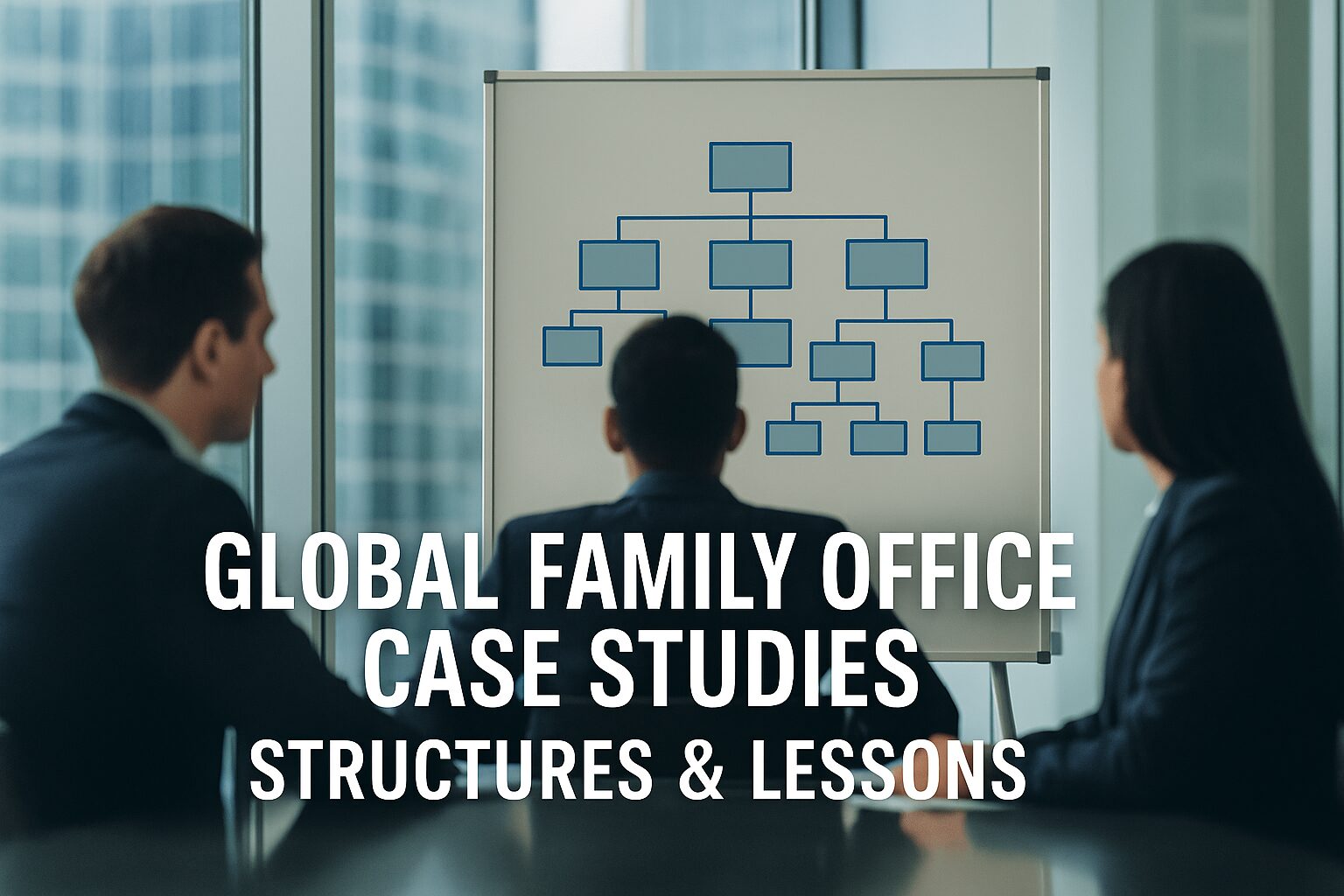Lessons Hidden in Billionaire Family Offices
Most wealthy entrepreneurs dream of building a family office, yet they often lack visibility into how the world’s richest families actually operate theirs. Investment policies and governance playbooks are important, but real organizational structures and case studies reveal the gap between theory and practice.
Across continents, billionaire families have built Single Family Offices (SFOs), Multi-Family Offices (MFOs), and hybrid structures. Their mistakes cost billions. Their successes shaped dynasties. By analyzing case studies — from old-money European banking dynasties to tech founders who cashed out in Silicon Valley — we uncover not just what to copy, but also what to avoid at all costs.
This article delivers a rare window into the blueprints, budgets, and organizational charts of family offices that actually exist.
Section 1: Archetypes of Family Office Models
1. Single Family Office (SFO)
- Full control, customized structure.
- Staff includes CIO, CFO, tax lawyers, estate planners, philanthropy leads.
- Advantage: privacy, alignment with family goals.
- Weakness: expensive (annual cost often $5–10 million).
2. Multi-Family Office (MFO)
- Shared infrastructure across multiple families.
- Provides institutional-quality service for a fraction of the cost.
- Advantage: access to professional teams, economies of scale.
- Weakness: diluted attention, conflicts of interest.
3. Virtual or Distributed Office
- Lean team + outsourced specialists.
- Uses technology platforms (Notion, Addepar, Carta).
- Advantage: low cost, flexible, scalable.
- Weakness: reliance on external providers, risk of misalignment.
Section 2: Operating Models in Practice
Investment-Led Offices
- Example: hedge fund founders turn family capital into an internal PE/hedge hybrid.
- Heavy focus on direct deals, co-investments, and proprietary research.
Governance-Led Offices
- Example: European aristocratic families.
- Emphasis on succession, charitable legacy, and asset protection.
- Investment returns secondary to continuity of governance.
Legacy-Led Offices
- Example: Middle Eastern dynasties.
- Core purpose: protect reputation, fund philanthropy, maintain influence.
Section 3: Case Study Deep Dive
Case 1: The Tech Billionaire’s Family Office (U.S.)
- Founded after a $5B IPO exit.
- Chose SFO model with 35 staff members.
- 50% allocation to VC and private equity (co-invest with top funds).
- Mistake: initial overexposure to crypto exchanges led to losses; later pivoted to institutional custody.
- Lesson: structure governance before chasing innovation.
Case 2: European Banking Dynasty
- 200-year-old family.
- Office structure focused on governance and philanthropy.
- Rotating family council every 5 years ensures leadership continuity.
- Lesson: governance-first structures prevent dynastic collapse.
Case 3: Asian Industrial Conglomerate Heirs
- Multi-generational, family wealth spread across 14 countries.
- Chose hybrid office: in-house investment + outsourced tax/legal teams.
- Pitfall: succession crisis when no clear heir; governance charter solved dispute after costly delay.
- Lesson: succession planning cannot wait until crisis.
Case 4: Middle Eastern Sovereign-Style Family Office
- Assets exceed $100B.
- Functions like a sovereign wealth fund: global real estate, energy, infrastructure.
- Internal staff of 200+, separate philanthropy foundation arm with $1B endowment.
- Lesson: scale requires industrial-level structure.
Section 4: Org Charts and Budgets
Sample Org Chart (Mid-Sized SFO)
- CIO (Chief Investment Officer)
- CFO (Chief Financial Officer)
- Legal/Tax Counsel
- Philanthropy Director
- Family Council Liaison
Budget Breakdown (Annual, ~$10B AUM SFO)
- Staff salaries: $5M
- Technology (Addepar, Bloomberg, risk software): $1M
- Legal/tax advisory: $3M
- Travel & due diligence: $2M
- Miscellaneous: $1M
Total: $12M per year to preserve and grow billions.
Section 5: What to Copy vs. Avoid
Copy
- Committee discipline (IPS + voting rules).
- Dual-track custody (crypto + banks).
- Succession timelines (codified in family charters).
Avoid
- Personality cults (decisions tied to one patriarch).
- Ad-hoc deals (no due diligence checklist).
- Tax mismatches (holding structures in unfriendly jurisdictions).
Section 6: Implementation Checklist
- Map which archetype (SFO, MFO, virtual) fits your family wealth size.
- Draft an org chart and assign key roles.
- Build a first-year operating budget.
- Define succession triggers (death, incapacity, retirement).
- Document governance in a Family Charter.
Conclusion: The Invisible Architecture of Billionaire Families
Billionaires are not invincible because they made perfect investments. They endure because they designed structures that withstand divorce, death, political storms, and generational disputes.
Every aspiring dynasty must study these cases not to copy blindly, but to adapt lessons into their own blueprint. Structures matter more than individual deals.
Case Study List
- Tech Founder’s Crypto Loss:
Lesson — governance before innovation. - European Banking Dynasty’s 200-Year Continuity:
Lesson — rotating family councils maintain stability. - Asian Succession Crisis:
Lesson — codify governance before disputes. - Middle Eastern Sovereign-Style Office:
Lesson — scale requires industrial systems.
Next Article Preview
Up next: The Complete Family Office Blueprint — Policies, Templates, and Checklists.
If Parts 1–7 were the individual building blocks, the hub page is the master map. In the next article, you’ll receive a one-stop blueprint with downloadable policies, IPS templates, risk checklists, org charts, and reporting packs. Without it, you’re left with fragments. With it, you hold the entire arsenal to turn family wealth into a dynastic fortress.
Subscribe CTA
🔔 Subscribe now to access the full Family Office Blueprint.
Every week, we share the same templates and checklists that billionaires use — normally locked behind $1M advisory retainers. Build the structure that takes your wealth from ₩200 billion to ₩4 trillion to ₩10 trillion.
